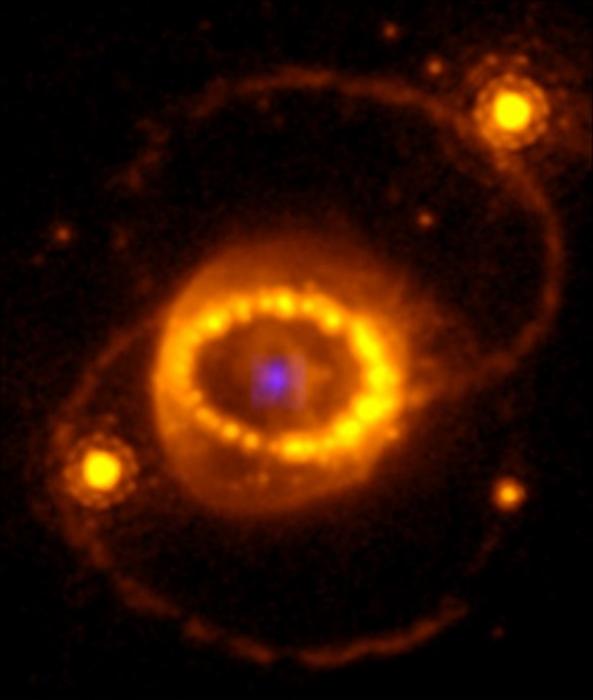A new study, published in Science and co-authored by Dr Patrick Kavanagh of Maynooth University’s Department of Experimental Physics in Ireland, has provided the first conclusive evidence for the presence of the elusive neutron star produced in the supernova SN 1987A.

Credit: C. Fransson (Stockholm University), M. J. Barlow (University College London), P. J. Kavanagh (Maynooth University), J. Larsson (KTH Royal Institute of Technology)
A new study, published in Science and co-authored by Dr Patrick Kavanagh of Maynooth University’s Department of Experimental Physics in Ireland, has provided the first conclusive evidence for the presence of the elusive neutron star produced in the supernova SN 1987A.
Supernovae are the spectacular end result of the collapse of stars more massive than eight to ten times the mass of the sun. Besides being the main sources of chemical elements such as the carbon, oxygen, silicon, and iron that make life possible, they are also responsible for creating the most exotic objects in the universe, neutron stars and black holes.
Supernova 1987A (or SN 1987A for short) was the first naked eye supernova in four centuries and provided astronomers with an unprecedented close-up view of a supernova explosion with modern observatories. Despite being one of the most studied objects in the sky, SN 1987A is not without its mysteries, with the most enduring question being ‘what did the explosion leave behind?’
The detection of neutrinos, unimaginably small sub-atomic particles produced in the supernova, indicated that a neutron star must have formed. However, whether or not the neutron star persisted or collapsed into a black hole has been one of the biggest unknowns regarding SN 1987A.
Even after three and a half decades of intense monitoring with cutting-edge, world-class observatories, no conclusive evidence for the presence of a neutron star at the centre of SN 1987A has been found, until now.
In a study published on February 22 in the journal Science, an international team of astronomers announced their discovery with the James Webb Space Telescope (JWST) of narrow emission lines from ionized argon and sulphur atoms located at the centre of a nebula around SN 1987A.
“It was so exciting looking at the JWST observations of SN 1987A for the first time,” said Dr Kavanagh, an SFI-IRC Pathway Fellow at Maynooth University in Ireland. “As we checked the MIRI and NIRSpec data, the very bright emission from argon at the centre of SN 1987A jumped out. We knew immediately that this was something special that could finally answer the question on the nature of the compact object.”
The authors of the study show that the emission line strengths observed by JWST must be triggered by radiation from the hot neutron star or from a pulsar wind nebula around the neutron star.
“Thanks to the superb spatial resolution and excellent instruments on JWST we have for the first time been able to probe the center of the supernova and what was created there,” said Claes Fransson of Stockholm University, the lead author of the study.
“We now know that there is a compact source of ionizing radiation, most likely by a neutron star. We have been looking for this from the time of the explosion, but had to wait for JWST to be able to verify the predictions.”
About Supernova (SN) 1987A
SN 1987A is the most studied and best observed supernova of all and therefore of special importance for understanding these objects. Exploding on 23 February 1987 in the Large Magellanic Cloud in the southern sky at a distance of 160,000 light years, it was the closest supernova since the last naked eye supernova observed by Johannes Kepler in 1604.
For several months before it faded SN 1987A could be seen with the naked eye even at this distance. Even more importantly, it is the only supernova to have been detected via its neutrinos. This is highly significant since 99.9 % of the enormous energy emitted in this event was predicted to be lost as these extremely weakly interacting particles.
The remaining 0.1 % appears in the expansion energy of the remnant and as light. Of the huge number — about 1058 — of neutrinos emitted, about 20 were detected by three different detectors around the Earth, from the collapse in the core of the star on February 23 at 7:35:35 UT.
SN 1987A was also the first supernova where the star which exploded could be identified from images that had been taken before the explosion.
Besides the neutrinos, the most interesting result of the collapse and explosion is the prediction that a black hole or neutron star was created. This constitutes only the central core of the collapsed star, with a mass of 1.5 times that of the Sun. The rest is expelled with a velocity up to 10% of the speed of light, forming the expanding remnant we observe directly today.
The ‘long’ 10-second duration of the neutrino burst indicated the formation of a neutron star, but despite several interesting indications from radio and X-ray observations, no conclusive evidence for a compact object had been found until now, and was the main remaining unsolved problem for SN 1987A.
An important reason for this may be the large mass of dust particles that we know was formed during the years after explosion. This dust could block most of the visible light from the center and therefore hide the compact object at visible wavelengths. This has now changed with the observation of SN 1987A at infrared wavelengths by a team using the James Webb Space Telescope.
Journal
Science
DOI
10.1126/science.adj5796
Method of Research
Observational study
Subject of Research
Not applicable
Article Title
Emission lines due to ionizing radiation from a compact object in the remnant of supernova 1987A
Article Publication Date
22-Feb-2024




